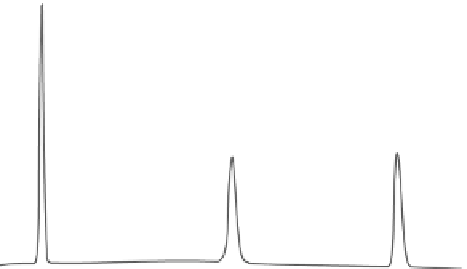Chemistry Reference
In-Depth Information
HPLC column eluent is first nebulized with a nitrogen (or air) carrier gas to form
droplets that are then dried to remove mobile phase, producing analyte particles
[22,23]. The primary stream of analyte particles is met by a secondary stream of
nitrogen (or air) that is positively charged as a result of having passed a high-voltage
platinum corona wire. The charge transfers diffusionally to the opposing stream of
analyte particles, and is further transferred to a collector, where it is measured by a
highly sensitive electrometer, generating a signal in direct proportion to the quantity
of analyte present.
Because the entire process involves particles and direct measurement of charge,
CAD is highly sensitive, provides a consistent response, and has a broad dynamic
range, which offers advantages when analyzing compounds lacking UV chromo-
phores, as illustrated in Figure 3.10. Often compared to other universal-type HPLC
detectors, such as RI and ELSD, CAD has been shown to be much easier to use,
and similar to ELSD but unlike RI, can accommodate gradients. In addition, CAD
response is not dependent on the chemical characteristics of the compounds of inter-
est, but on the initial mass concentration of analyte in the droplets formed upon
nebulization, providing a much more uniform response as opposed to, for example,
UV, where responses can vary dramatically according to the wavelength used and
the extinction coefficient.
Mass spectrometry is a powerful analytical technique that can be used to confirm,
quantify, identify, or characterize compounds of interest. Mass spectrometers mea-
sure the mass-to-charge (m/z) ratio of ions in the gas phase, allowing the determina-
tion of a compound's molecular weight (to varying degrees of accuracy). By breaking
apart molecules into fragments, MS can also be used to analyze smaller portions
(×100,000)
ClO
4
-
1.75
NO
3
-
Cl
-
1.50
1.25
PO
4
3-
1.00
SO
4
2-
K
+
Na
+
Li
+
0.75
0.50
0.25
5.0
10.0
15.0
20.0
min
FIgure 3.10
Simultaneous analysis of anions and cations using HILIC/CAD. Conditions:
A Sequant ZIC
®
-
p
HILIC 5 mm, 4.6 × 150 mm column (The Nest Group, Southborough,
Massachusetts) operated at 30°C was used. Gradient conditions: 20 to 70% B over 26 min;
mobile phase A: 15% 100 mM ammonium acetate pH 4.68, 5% methanol, 20% IPA, 60%
acetonitrile; mobile phase B: 50% 30 mM ammonium acetate pH 4.68, 5% methanol, 20%
IPA, 25% acetonitrile, at a flow rate of 0.5 mL/min and a 10-µL injection.




















